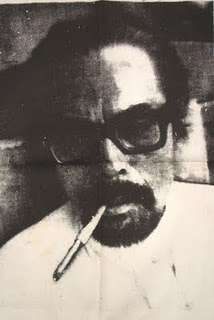Aung Soe
Bagyi Aung Soe (Burmese: ဗဂျီ အောင်စိုး [bədʑì ʔàʊɴ só]; 1924–1990) was a Burmese painter renowned for his modernistic, semi-abstract art, which caused such a shock in Burma when it appeared that many called it "psychopathic art".[1] The name "Bagyi" is his phonetic spelling of the word "pangyi", meaning "painting", which he first added to his name in 1955.[2]
Bagyi Aung Soe ဗဂျီ အောင်စိုး | |
|---|---|
 | |
| Born | 1924 Rangoon, British Burma |
| Died | 1990 (aged 66) Yangon, Myanmar |
| Nationality | Burmese |
| Known for | Painting |
| Movement | Modernist (abstract-figurative)Painting |
Santiniketan and Early Life in Burma
The Indian government offered him a scholarship in 1951 to study art at Santiniketan, founded by Nobel laureate Rabindranath Tagore, but he chose to return to Burma after only a year. He traveled throughout Burma studying its handicrafts, classical art and architecture, especially that of Bagan.[3] In early 1953 one of Aung Soe's abstract paintings was published in Shumawa magazine, causing considerable controversy. Some said that the artist was mad.[4]
Trip to Peshawar, Afghanistan and Russia
In the winter of 1953 he was able to visit Peshawar, Afghanistan and Moscow for art studies. It has been alleged that in Russia he saw the works of modern European masters such as Picasso, Matisse and Kandinsky, but this can hardly be true because the work of the European modern masters was in deep storage in Russia and unavailable to public view during the Stainist period and for many years afterwards. However, it is clear that Aung Soe was influenced by European painters such as Picasso and Matisse, probably Japanese painting (one work shows influence of sumi-e), and the work of painters at Santiniketan, both contemporary and deceased, whose works were in the Santiniketan Museum.[5] During his time at Santiniketan, Aung Soe met the Indonesian expressionist painter Affandi, who also influenced him.[5] In addition to these foreign influences, Aung Soe was deeply influenced by the long history of Burmese Traditional painting, stretching back to the time of Bagan, which can still be seen on the walls of temples of the old city there.[5]
Later life in Burma
After this, he had to depend on the Rangoon University library for art books as a source of inspiration. An eccentric, at times drunken and emotional, he had few friends in the artistic community, and few who shared his views on art. He worked alone, but did show his work in informal underground exhibitions, introducing concepts such as Cubism and Surrealism.[3]
To earn money, Bagyi Aung Soe painted for magazines and book covers until the end of his career. At times his family was so poor that his wife had to sell mohinga, a noodle soup, to support them.[6] Bagyi Aung Soe suffered poverty and isolation and never found success during his life. He died in 1990, going deaf and blind.[1][5]
Work

Aung Soe thought deeply about the relevance of art in 20th-century Burma. According to Yin Ker, "He aspired for his paintings to be visual translations of Buddhist truths, not mere illustrations of episodes from the Buddha's previous lives or pretty pictures of pagodas and monks". In his later years, in poverty and with failing health, he became increasingly obsessed with creating an artistic idiom that reflected the Buddhist laws of impermanence.[3] His biographer has said "he transposed his spiritual aspirations and experiences into his artistic mission statement and applied their practical methods to the act of creation".[7]
Though Aung Soe's talent was unrecognized during his life, he is now among the most admired and most famous of Burmese modern artists.[6][8] Less than ten years after his death, his paintings fetched thousands of dollars in Indonesian art galleries.[6] The organizer of a 2009 exhibition in his honor said "almost two decades after his death, his art continues to fascinate and stimulate".[9]
Museum Collections
See also
Notes
- Nyan Shein (1998). "Bagyi Ang Soe (1924-1990)". On Burmese Painters, Sculptors, and Architects, Vol. 2 (in Burmese). Sarpay Beikman. pp. 177–185.
- Yin Ker (2005). "Modern Burmese Painting According to Bagyi Aung Soe" (PDF). Journal of Burma Studies. DeKalb: Center for Southeast Asian Studies, Northern Illinois University. 10: 84–87.
- Yin Ker (May 2004). "Creation in Isolation: The Life and Career of Bagyi Aung Soe". The Irrawaddy. Archived from the original on 16 November 2010. Retrieved 2010-11-17.
- "OM : BAGYI AUNG SOE & OTHERS". PANSURIYA. 6 December 2009. Retrieved 2010-11-17.
- Andrew Ranard (2009). Burmese Painting: A Linear and Lateral History. Silkworm Books. pp. 240–253. ISBN 978-974-9511-76-3.
- SAN SAN TIN (Aug 2001). "Mentor and Tormentor". The Irrawaddy. Retrieved 2010-11-17.
- Yin Ker (13–15 July 2006). "Findings from Bagyi Aung Soe's Late Works: An Unwonted Union of the Sacred and the Avant-garde?". The Asia Research Institute. Retrieved 2010-11-17.
- Thomas Streissguth (2007). Myanmar in Pictures. Twenty-First Century Books. p. 50. ISBN 0-8225-7146-3.
- Nyein Ei Ei Htwe (December 14–20, 2009). "Say 'Om' at art exhibition". Myanmar Times. Archived from the original on 2010-01-04.
Further reading
- Ranard, Andrew (2009). "The Modernist Movement: The Outsiders". Burmese Painting : A Linear and Lateral History. Silkworm Books. pp. 240–253. ISBN 978-974-9511-76-3.CS1 maint: ref=harv (link)
- "L'art fou ou art moderne birman selon les illustrations de Bagyi Aung Soe" (in French)
- "The Legacy of Bagyi Aung Soe - 20th Anniversary" (PDF) (in Burmese). July 2010. Archived from the original (PDF) on 2011-07-07. Retrieved 2010-11-16.
External links
- AungSoeIllustrations.org - An open-access online database of periodical and book illustrations and covers by Bagyi Aung Soe (1923/24–1990).